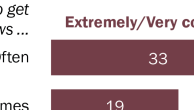By Marya Jones
There is no doubt the name of the game in local TV news is ‘live, local and late-breaking’ more than ‘thorough, thoughtful and timely.’ Is this run-and-gun-style dictated by the nature of the television medium? Or is it a reflection of the resources and staffing companies are devoting to local TV news? To find out, researchers sent questionnaires about resources to all stations studied and compared the answers to the findings about quality and ratings. The results revealed there is no direct correlation between having more resources and producing higher quality news. Quality is not only a question of how much you have, but also how you use it. Yet that is only part of the story. The questionnaires reveal that even the richest stations have staffing levels that stretch everyone thin and fundamentally limit the nature of the work local TV news can produce. The underlying issue is that the high profit margins expected of local television news operations – often in excess of 40 percent – foster a culture of superficiality and haste in covering the news. On average, stations expect their reporters to produce 1.5 stories a day – a demand that leaves little time for digging deeper or developing expertise, let alone reflection. No station responding to the survey expected less than a story a day on average.
The questionnaires asked news directors about newsroom structure, staffing, management stability, budgets and more. Of the 61 stations sent questionnaires, 32 responded – mostly smaller stations and, interestingly, mostly stations with higher quality scores and higher ratings. The questionnaires reveal that money does not equate to quality or ratings in any quantifiable sense. In the study, stations in moderate-sized cities tended to score higher for quality than those in major cities, and not surprisingly, the questionnaires confirm that they had smaller budgets. This probably reflects a more basic fact: that doing business in big cities is just a lot more expensive. A comparison of stations of the same market size finds that there still is no clear relationship between budget and quality or ratings. In part, this is because quality appears to correlate to effort, and it doesn’t necessarily cost more money to make the extra phone call, think smart, and be locally relevant. But this masks the bigger problem that the answers to the questionnaires suggest: Few have the time or resources to do any more than minimally fill an ever-expanding news hole. Some stations expect as many as three stories a day from their reporters. This makes a spate of recent cutbacks in local news all the more a matter of concern. The problem is structural. Local television news is an industry with a growing supply of stations and a rising number of hours of news to produce, faced with an already shrinking audience. The only way to maintain historically high profits is to cut costs and increase productivity. This only exacerbates the problem of low quality.
Local TV professionals seem to know it. “There is always a deadline looming and we can’t give our reporters the time we’d like to dig deeper,” wrote an executive in one questionnaire. “Everyone has to churn product everyday,” said another. “Many newscasts but not enough news gatherers,” said a third. In all, 17 of the 32 news directors responding considered time and staffing their key concern. Another six raised the same concern by another name – budget or resources. But they weren’t talking about the money needed for more technology. All of these concerns about budget again related to staffing. “My obstacles are staff, equipment and, most importantly, money,” one small-market news director said. “Money – for staff and resources,” said another from a large market. “It takes time and resources to find and properly explain complex stories which will affect viewers.” Looking at the number of reporters employed paints an even bleaker picture of the way newsroom staffs are stretched. On average, stations responding to the survey employed 15 reporters – a number that in most cases includes anchors and weekend talent. Given that stations produce on average four hours of news a day, this, counting generously, works out to four reporters for every hour of news. Under these staffing constraints, quality may be not only a challenge but often an accident. What role does technology play in affecting quality or ratings? Anyone watching TV has probably seen station promos touting new helicopters or weather radar. One small-market station even flaunted that its chopper had a steady-cam.
Do audiences really care – outside of focus groups? The study found no statistically significant evidence to suggest a helicopter helped propel ratings. Future years of the study will provide more data, but a sample of 32 stations is enough to suggest that the effect of getting a helicopter will hardly be magical. Smaller market stations seem to get more out of their money because they stay local. Larger market stations often spend their money on stories that take them away from home. Many needlessly send a reporter to Washington or a foreign country when the local angle is right under their noses. But no station in the study was breaking the larger mold by giving large numbers of reporters significant amounts of time to develop pieces. Those producing quality and depth are doing it by their wits, and against the odds.
Marya Jones, a research associate on this project, is a graduate of Northwestern’s Medill School of Journalism in Chicago.




